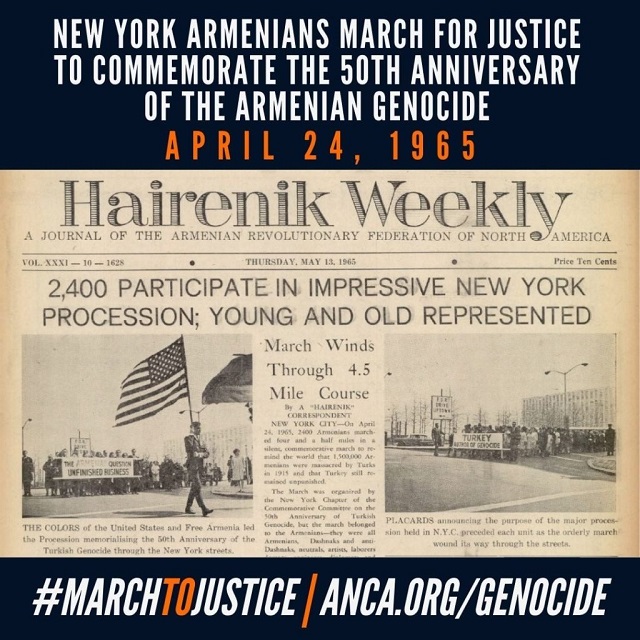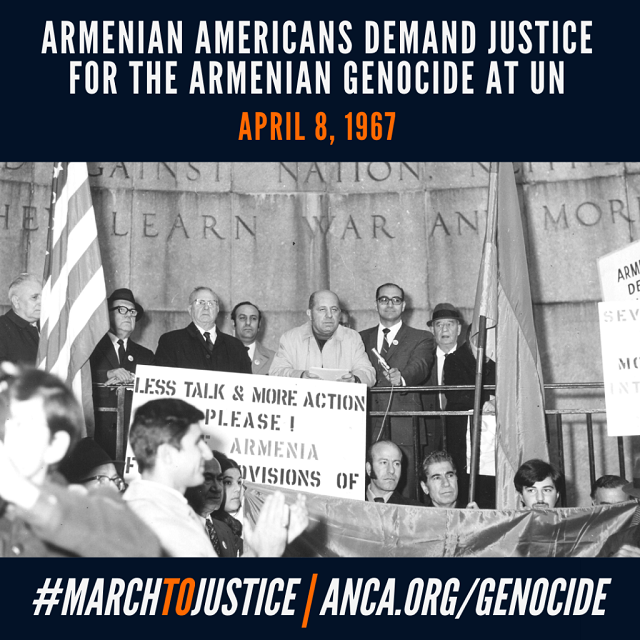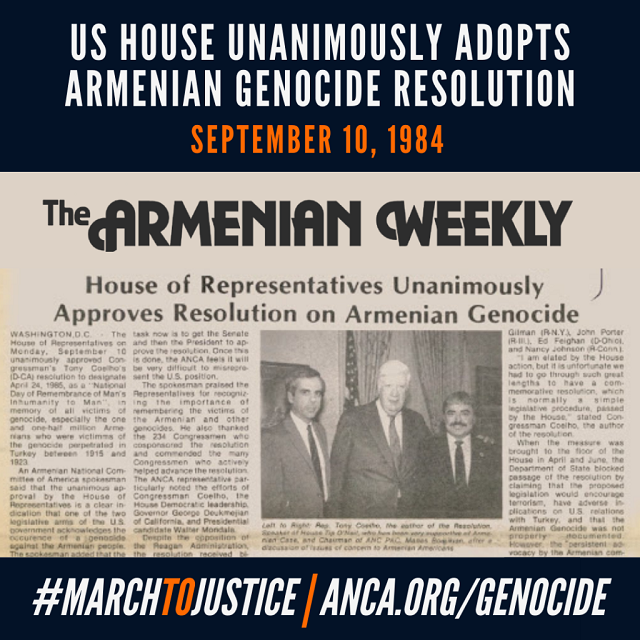This year, the Armenian National Committee of America (ANCA) highlighted its March to Justice initiative on social media. Following Pres. Joe Biden’s recognition and remembrance of the Armenian Genocide on April 24, the Weekly interviewed ANCA Communications Director Elizabeth Chouldjian about the importance of the campaign and its impact following the President’s momentous statement. We also spotlight some of the Facebook posts that began this year on April 1.
Armenian Weekly (A.W.): What inspired this year’s #MarchtoJustice social media campaign?
Elizabeth Chouldjian (E.C.): The ANCA’s broader March to Justice initiative was announced on the 100th anniversary of the Armenian Genocide. That April, with the leadership of our IT director Nerses Semerjian, we launched the ANCA’s new action platform that made it easier than ever for our community members to share their views with legislators on the federal, state and local level. It’s powered by the ANCA’s Rapid Responder network, Quick Connect Congressional Call system and our latest ANCA Frontrunner social media ambassadors program.
Read also
This year’s April campaign was inspired by the Hairenik/Armenian Weekly digitization project. We wanted to take a look back at the incredible work done by the ANCA and community advocates in generations past – work that laid the groundwork for the US policy change we saw on April 24th.
The Hairenik and Armenian Weekly coverage of the activism at that time – which also included coverage from local US papers from across the US – offers an incomparable snapshot of history and helped us mark milestones on the Armenian American community’s march to justice.
A.W.: The posts included a call to action demanding Pres. Biden to honor his pledge to recognize and commemorate the Armenian Genocide properly. Recently, the ANCA reported that over one million people did just that. Has this outcome surprised you? What goals did you hope to achieve with the initiative?
E.C.: The ANCA had targeted a million messages – inspired by the incredible community activism we saw during the 44-day Azerbaijan/Turkey attack on Artsakh and Armenia in the fall. We hoped to keep the pro-Armenian advocacy momentum going with this call on the White House to end US complicity in Turkey’s denials, while also focusing on ongoing community concerns – from Azerbaijan’s release of Armenian POWs to getting aid to Artsakh and Armenia.
The goal was simply to build on the decades of grassroots activism that led to 49 US states recognizing the Armenian Genocide and the near-unanimous Senate and House adoption of Armenian Genocide legislation in 2019. President Biden knew the issue well as Senator and Vice-President. He was an outspoken leader on Senate Armenian Genocide affirmation throughout his career. The grassroots campaign was to send the message that if human rights is really to be a central goal in the Biden administration, then speaking truthfully about the Armenian Genocide is a prerequisite for his human rights policies to be taken seriously.

On April 24, 1965, thousands of Armenian Americans gathered in New York City for the first major US march for justice for the Armenian Genocide. The 4.5-mile march was organized by the New York Chapter of the Commemorative Committee on the 50th anniversary of the Genocide, led by Armen Boyadjian, Varoujan Asbedian, Aram Papazian and many others.
A.W.: You noted the valuable resource of the Hairenik archives in providing information for the initiative. What would you like to tell our readers about the archives, their importance and their value to our community?
E.C.: The Hairenik archives are an invaluable resource to document our community’s progress over the past century. It truly is a snapshot in history – a window into our communities and their priorities over the decades. In addition to ANCA and community advocacy-related research, I have used the tool in my capacity as a local AYF chapter advisor to learn more about the Washington, DC chapter’s formation and activism over the years. The DC “Ani” chapter is going to be celebrating its 80th anniversary next year and the Hairenik archives are helping us document milestones in chapter life. The same can be done with so many aspects of our community and organizational life.
A.W.: Is Pres. Biden’s recognition of the Armenian Genocide the ultimate goal of the campaign? Does it go beyond that outcome, and if so, how?
E.C.: By recognizing the Armenian Genocide, President Biden ended the shameful era of US complicity in Turkey’s Armenian Genocide denial. It sent a powerful message to the Erdogan regime that it’s the US – not a genocidal Turkey – that decides how we speak about this crime.
President Biden’s recognition comes at a particularly poignant time – just months after Turkey and Azerbaijan’s genocidal attacks on Armenia and Artsakh. Today, we have over 100,000 displaced from their homes, over 200 Armenian POWs still illegally imprisoned by Azerbaijan and Azerbaijani threats to attack Syunik.
President Biden’s recognition must translate into a fundamental reset in US policy toward the region – one which ensures the security of Armenia and Artsakh, and lays the groundwork for a durable peace based upon a just resolution of the Armenian Genocide.
A.W.: Any final thoughts on the march to justice of the Armenian people and nation, particularly following the disastrous 2020 Artsakh War?
E.C.: What the nation has lived over the past six months is something every Armenian has been forewarned by generations past. My colleague Alex Galitsky said it best in an article recently. The Armenian Genocide did not end 106 years ago. It continues to this day, perpetuated by Turkey’s continued obstruction of justice for the victims and survivors of genocide, and the ongoing existential threat the Armenians of Artsakh face at the hands of Turkey and Azerbaijan, informed by the same ideology of aggressive expansionism that led to the genocide over a century ago.
In the face of this reality, the ANCA is advancing initiatives to help protect the independent Republics of Armenia and Artsakh, expand the US-Armenia/US-Artsakh partnerships, secure justice for the Armenian Genocide – all part of a single aim: the security, prosperity and long-term viability of a free, independent and united Armenian homeland.
To that end, the march to justice continues.

On April 8, 1967, the American Committee for the Independence of Armenia and the ANCA organized a protest at the United Nations demanding the creation of an international tribunal to try and punish those guilty of the crime of genocide. Complete coverage of the protest was shared in the May 11, 1967 issue of the Armenian Weekly.
Main Photo Caption: In 1984, the U.S. House unanimously adopted the H.J.Res. 247 recognizing the Armenian Genocide. The resolution stated: “Resolved by the Senate and House of Representatives of the United States of America in Congress assembled, That April 24, 1985, is hereby designated as ‘National Day of Remembrance of Man’s Inhumanity to Man,’ and the President of the United States is authorized and requested to issue a proclamation calling upon the people of the United States to observe such day as a day of remembrance for all the victims of genocide, especially the one and one-half million people of Armenian ancestry who were the victims of the genocide perpetrated in Turkey between 1915 and 1923, and in whose memory this date is commemorated by all Armenians and their friends throughout the world.”






















































